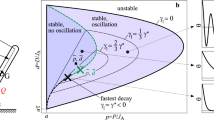Abstract—Problems of optimal control were analyzed for a human motion model for stabilometric tests where the posture changes under a stepwise input action. The presence of a prominent “swing” and an “overshoot” are characteristic of the center-of-pressure trajectories recorded in the test. A one-dimensional inverted pendulum model was used in the study. The solution of the optimal control for the inverted pendulum motion controlled by coupling torque was put in correspondence with the test results. The problems of optimal speed-of-response control and linear–quadratic regulator were considered. The solution of these optimum problems was compared with the stabilometric test results. A modified algorithm was proposed for stabilometric data processing. This motion was shown to reach a stable motor pattern. The swing and overshoot were found to correspond to the acceleration and deceleration stages, respectively.





Similar content being viewed by others
REFERENCES
F. B. Horak and F. J. Hlavacka, J. Neurophysiol. 86, 575 (2001).
G. A. Pereyaslov and S. S. Sliva, Izv. TRTU 5 (28), 82 (2002).
B. N. Smetanin, K. E. Popov, and G. V. Kozhina, Neurophysiology 36 (1), 58 (2004).
V. Yu. Shlykov, T. B. Kireeva, and Yu. S. Levik, Izv. Yuzhn. Fed, Univ., Tekh. Nauki 6 (83), 112 (2008).
Yu. S. Levik, T. B. Kireeva, and V. Yu. Shlykov, Al’manakh Klin. Med. 17 (2), 217 (2008).
E. P. Murtazina, Izv. Yuzhn. Fed, Univ., Tekh. Nauki 9 (98), 123 (2009).
G. S. Kashevarov, O. I. Elkina, and R. R. Kasimova, Lechebn. Fizkul’t. Sport. Med. 4 (130), 36 (2015).
I. Yu. Gorskaya, L. G. Kharitonova, A. A. Tereshchenko, and O. V. Krizhivetskaya, Sovr. Probl. Nauki Obraz., № 2 (2017). http://www.science-education.ru/ru/article/view?id=26193. Cited June 26, 2019.
P. A. Kruchinin and E. A. Kasatkin, Izv. Yuzhn. Fed, Univ., Tekh. Nauki 10 (159), 254 (2014).
P. A. Kruchinin, Moscow Univ. Mech. Bul., No. 2(71), 45 (2016).
P. A. Kruchinin, Russ. J. Biomech. 18 (2), 158 (2014).
M. Athans and P. Falb, Optimal Control: An Introduction to the Theory and Its Applications (McGraw Hill, 1966).
Ya. N. Roitenberg, Automatic Control (Nauka, Moscow, 1971) [in Russian].
A. L. Hof, J. Biomech. 36 (7), 1031 (2003).
B. J. Thompson, E. D. Ryan, T. J. Herda, et al., J. Electromyogr. Kines. 22 (6), 893 (2012).
V. V. Aleksandrov, S. I. Zlochevskii, S. S. Lemak, and N. A. Parusnikov, Introduction to the Dynamics of Controled Systems (Moscow State Univ., Moscow, 1993) [in Russian].
A. D. Kuo, IEEE Trans. Biomed. Eng. 42 (1), 87 (1995).
S. G. Carver, T. Kiemel, N. J. Cowan, and J. J. Jeka, Biol. Cyber., No. (2009), 35.
P. Paoletti and L. Mahadevan, J. R. Soc. Interface 9, 2097 (2012).
A. L. Hof, Gait & Posture 4 (3), 222 (1996).
L. I. Sedov, Methods of Similarity and Dimensions in Mechanics (Nauka, Moscow, 1977) [in Russian].
I. V. Novozhilov, Fractional analysis. Methods of Motion Decomposition (Birkhäuser, NY, 1997).
A. P. Kruchinina and A. G. Yakushev, Moscow Univ. Mech. Bul., No. 4 (73), 97 (2018).
Funding
This work was supported by the Russian Foundation for Basic Research (project no. 18-00-01590).
Author information
Authors and Affiliations
Corresponding author
Ethics declarations
Conflict of interests. The author declares that he has no conflict of interest.
Statement of compliance with standards of research involving humans as subjects. All procedures performed in studies involving human participants were in accordance with the ethical standards of the 1964 Helsinki Declaration and its later amendments. Informed consent was voluntarily provided by all individual participants involved in the study.
Additional information
Translated by T. Tkacheva
Rights and permissions
About this article
Cite this article
Kruchinin, P.A. Analysis of the Results of Stabiolmetric Tests with a Stepwise Input Action in the Context of the Mechanics of Controlled Systems. BIOPHYSICS 64, 818–827 (2019). https://doi.org/10.1134/S0006350919050130
Received:
Revised:
Accepted:
Published:
Issue Date:
DOI: https://doi.org/10.1134/S0006350919050130




